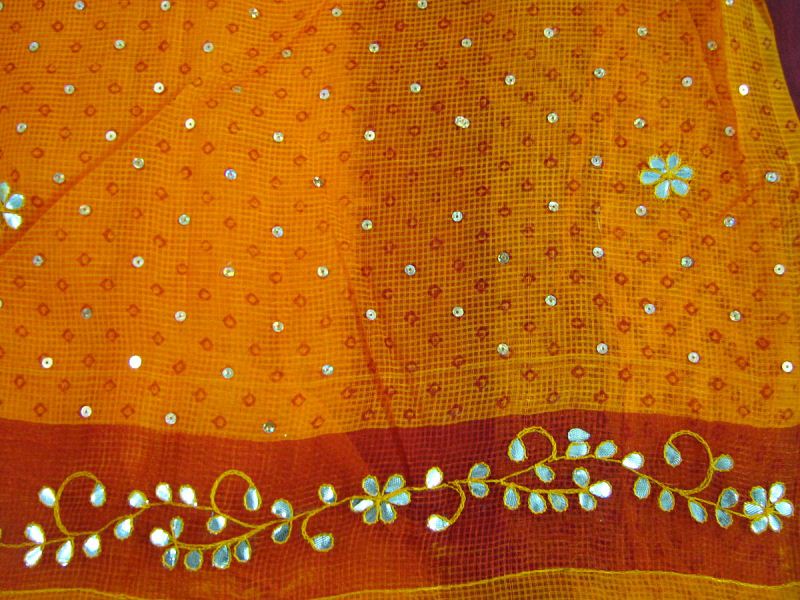A journey to Kaithoon of Kota, Rajasthan – Place of origin of Kota Doria Saris
There is one special Kota sari, which has some silk content – that’s the peculiarity of Kota Doria Sarees, which originates from Kaithoon town of Kota District from Rajasthan. These light-weight traditional saris have some special sari border designs. Square checks pattern locally known as khats, distinguish them among different sari patterns. Saris with block prints are also available. So let us start for a journey to Kota of Rajasthan, to know about the fascinating stories of trademark Kota Doria Saris.
Still Kota Doria Sarees born in Kota?

Answer is ‘Yes’. Nowadays Kota is best known for IIT coaching centres. It’s said that more than 40% students who get admission to IITs every year study from Kota. It’s said that in the first half of 1960s, many people used to wait to Kota railway station to take away educated people from Kerala and other Indian states, who arrive there in trains. Later many of them got settled there with their profession. For the same reason there are many people in Kota, who are originally from other states.
Kaithoon is 22 kms away from the main town of Kota District where the traditional Kota Doria Sarees are born. It’s a very beautiful and remote village which lies in the desserts of Rajasthan. In every home of this village, there will be at least 1 or 2 looms. Now more than 3000 families are associated with this profession, who still live there.
Where are those deserts?
Wheat fields are seen on either side of road. You can see machines used for weaving and haystacks here and there. You might be surprised to know that Rajasthan also owns agricultural fields in almost every region except northern desert areas of Jaisalmer.
Kaithoon – the sari village has only narrow roads, where big vehicles won’t enter. Congested homes with single rooms and veranda is the common sight. Most of the homes have looms. They hand different colours of sari threads in cloth lines within the home interior. On the either side of narrow roads, you can see drainages. Ladies cover their heads with red pallus, which is a common sight.
Village heads known as Sarpanchs
Streets are narrow and interconnected, and also filled with goats. You can see Sarpanchs and his associates, respected by local people. The streets make you remember Hindi films which you watch on television, which tell the stories of rural villages. Temples, local schools, homes, neem trees, old people sitting on beds outside homes etc are some of the common sights of these villages, which form a part of rural culture of Rajasthan.
Women sit on floors during the process of weaving
A traditional pit loom is used for the weaving process. A hole in square shape is made on floor and legs are fixed into it during the weaving process of ladies. A thread extends from loom to legs. Legs and hands are moved in rhythm during the weaving process. To wind thread in bobbin is a tedious process, as threads often break.
Those threads hung in cloth lines are so beautiful. For every woman in Kaithoon, the day begins with dyeing process. The process should be done in early morning. Then only the threads will be completely dried in a single day under direct sun. They repeat the process two more days till the threads are dried perfectly. Then they dip the threads in rice paste and also onion juice to make them stiff, and then made into bundles. No additional finishing is needed. Then these bundles are inserted into the looms for weaving process. The machine stops only after weaving 4 saris. Square check patters – trademark design of Kota Doria saris.
Some saris will have silk designs. It needs special skills to fix silk threads inside the bundles to get perfect silk designs in saris. Now wedding saris costing 50000 rupees are also woven in the looms of Kota, where golden threads are added. You can get both cheap Kota saris as well as saris costing 25000 rupees or more. The only profit is the labour cost. In simple words, they don’t earn too much.
In most homes kids discontinue their studies at school to help parents. Later they traditionally follow the family profession. Girls start training at the age of 8 or 10, and mostly women are associated with weaving clothes. Men usually go for work outside. Thus it gives a good income to ladies at home, who are mostly illiterate.
Threads for weaving are supplied by agencies from Bangalore and Surat. Later they give only labour cost to weavers, and earn huge profits in big cities. That’s the main reason why they couldn’t give good education to kids. They often hide their pains and sufferings, and carry forward the family tradition with the little satisfaction they get through weaving. They are broad minded people who treat visitors with open heart, and also invite them to homes.
Village showrooms
There is a single showroom in the village, dedicated to visitors who come in search of traditional Kota Doria Saris. With a few almarahs in a congested room, they often various designs to the guests. Only a few saris are available there, as most of the saris are taken away by agents.
Now such saris are made in power looms in Ahmedabad and Surat using synthetic threads. You can easily identify original and duplicate saris, merely touching it using fingers. They are not soft. When soaked they won’t turn soft like cotton.
History of Kota Doria Saris
In the 17th century the commander in chief of Mughal Army, Rao Kishore Singh was the person behind the origin of Kota saris. There is an interesting story behind it. Singh married the princess of Udaipur, the land known for streams and lakes. As Kota is a hot place comparing with Udaipur, the king built an artificial lake and a palace for the princess. As he noticed that she feels discomfort with hot dress, he decided to gift her with hand woven and light weighted dress.
As a part of his military invasions and travels towards South India, when he reached Mysore, he noticed light weighted hand woven saris woven by traditional methods, suited for any climatic conditions. Later he brought expert weavers from Mysore to Kota, and very soon weaving flourished there. Kota Doria fabric is considered as the royal fabric of Rajasthan, which used to be worn by the royal members of the family then. Now it’s high in demand in Indian markets, especially red coloured ones.
A few more places to visit in Kota
Rao Madho Singh Museum – It’s a historical museum of Kota, and it opens to visitors 6 days a week except Fridays (visiting hours – 10 am to 4. 30 pm).
Jag Mandir – It’s a palace built by Kota’s Maharani in year 1740. It was built in the centre island of Kishore Sagar artificial lake. People don’t have permission to enter there, but they can go near to Jag Mandir by boat and see it near.
Chambal Garden – Gardens of industrial town Kota are also famous. This garden is situated on the banks of Chambal river and is one the southern side of Kota.
Baroli – Situated 56 kms away from Kota in south-west direction, it’s a group of ancient temple structures. Originally built in the 9th century, many of the temples are in damaged condition, caused by foreign invaders.
How to reach Kota?
Kota is an industrial town situated on the banks of Chambal River. The city is also famous for education centres and military barracks. Kota is the main railway station to reach the place, and you can reach the place from anywhere across India. From Kochi it takes a total of 1.5 days and 1.5 nights to reach the place, by train. Jaipur is the nearest airport.
Also read a few more articles on tourist locations outside Kerala. Click on the images in the gallery to read
















Recent Comments